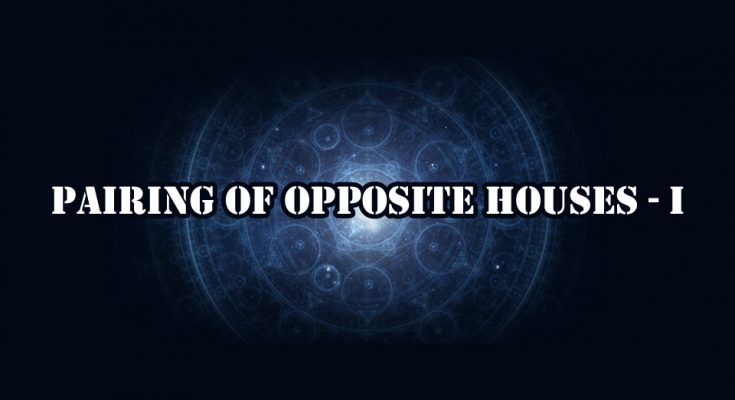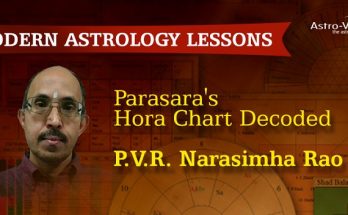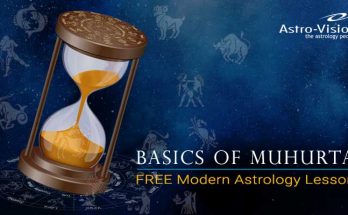The 12 houses in a horoscope signify all the areas of life of an individual. Starting from the Ascendant, which functions as the focal point, the significations of the 12 houses flow in a natural order according as the life of a person begins and unfolds stage by stage with the passage of time starting from birth. No house is more important and none is less important than any other. Grading or drawing up a priority list would be improper, if not fallacious. Depending upon the native’s individual perceptions certain areas of life signified by certain houses may seem to be more important than others which may not be universally applicable.
A proper understanding of the roles of houses and an effective use of their significations is essential for better accuracy in prediction. Although the role of planets and signs in the fructification of events in one’s life cannot be undermined, the houses function as the rudimentary canvas on which the pictures of life are painted by the planets and signs which are driven latently by the invisible Karmic force.
The use of opposite houses in prediction is the subject matter of this paper.
Interlinks Between Houses
It is an irrefutable fact that all the houses in a horoscope are interconnected with one other. Moreso, that some houses are more intimately interconnected while simultaneously being less connected to other houses. Based on such interlinks only, the 12 houses have been classified as Kendras, Trikonas, Dustanas, Upachayas, Panaparas, Apoklimas, Marakus, Badhakas, etc
The 3rd, 6th, 8th and 12th houses have been called Dustanas (3rd house is excluded by some) for primary reason that they negate the influences of either a Kendra or a Trikona by being the 12th house from a Kendra or a Trikona. That is they cause losses to a Kendra or Trikona by signifying certain adverse areas of one’s life such as enemies, disease, disturbances, expenditure, losses, etc.
The houses included in each of these groupings signify a common pattern of results. For example, the 3rd, 6th, 8th and 12th houses have been called Dustanas (3rd house is excluded by some) for the primary reason that they negate the influences of either a Kendra or a Trikona by being the 12th house from a Kendra or a Trikona. That is, they cause losses to a Kendra or Trikona by signifying certain adverse areas of one’s life such as enemies, disease, disturbances, expenditure, losses etc. Although these four houses are grouped together due to the common and adverse nature of their significations, the influence of each house is exclusive as their individual significations happen to be different. Similar is the case with other groupings as well.
However, it is pertinent to note that even among the houses falling in a particular group some houses are more closely related to one another than others. Let us take the Dustanas again. They generally signify certain unpleasant areas of one’s life. But, even out of these four Dustanas, the 6th is more closely related to the 12th than the 8th or the 3rd. The cure from a serious disease may necessitate hospitalization which involves expenditure as well (12th house) and any redemption from debt (6th house) involves repayment (or expenditure) or loss without any consequential benefit while in most cases the adverse influence of enemies (6th house) would be directly responsible for unwanted expenses and financial losses in many ways.
The 3rd house signifying one’s effort and loss of happiness (12th from the 4th) and the 8th house signifying expenditure of luck or Prarabdha (12th from the 9th) indicate the longevity or the time span within which one’s Karmic debt is to be paid back through suffering or otherwise (8th and 8th from the 8th).
Looking at this link from the esoteric point of view, the 6th house signifies runa (Karmic debt) from which one has to get redeemed in this life so as to attain Moksha (freedom from the present birth) signified by the 12th house. The 3rd house signifying one’s effort and loss of happiness (12th from the 4th) and the 8th house signifying expenditure of luck or Prarabdha (12th from the 9th) indicate the longevity or the time span within which one’s Karmic debt is to be paid back through suffering or otherwise (8th and 8th from the 8th). Obviously, the interlink between 6th (runa or Karmic debt) and the 12th (Moksha or redemption of debt) is of prime importance while the effort or loss of happiness (3rd house) and the time factor or sufferings (8th house) are secondary in nature.
When all the houses in a horoscope are examined with an eye on such subtler links, it is seen that pairing opposite houses and analyzing them provides better insights into a nativity as the opposite houses have a special mutual impact on each other.
Opposite Signs
Everything in Nature exists in opposite pairs or duality — day and night, good and bad, Purusha and Prakriti, etc. Despite their opposite natures, they exhibit harmony and balance on the earth. The natal chart is no different. In the Zodiac, the signs in Samasaptaka or in opposite positions are of the same nature and gender as shown in Figure 1.
Aries opposes Libra and both are odd, male and movable signs. Taurus opposes Scorpio and both are even, feminine and fixed signs.
Gemini opposes Sagittarius and both are odd, male and dual signs. Cancer opposes Capricorn and both are even, male and movable signs.
Leo opposes Aquarius and both are odd, male and fixed signs. Virgo opposes Pisces and both are even, female and dual signs. It must also be noted that the Tattwa (element) ruled by the opposite signs are not the same but are friendly in nature. Each of these natures connotes a particular pattern of energy inherent in the sign. Similar natures undoubtedly exhibit similar energies.
Now, let us examine the opposite houses of the natural Zodiac in the light of the Law of Magnetism which states that “like poles repel each other and unlike poles attract each other”. That means, similar magnetic energies are mutually repulsive while the opposites ones are mutually attracted to each other. As the opposite houses in the Zodiac possess the same qualities they naturally tend to create repulsive influences which would give rise to conflict. At the same time, because their elements are friendly, they would inherently work towards establishing a harmonious balance rather than ending up with discord, unless other predominant influences adversely affect and destabilize them.
Pairing Opposite Houses
The nature of opposite houses in a horoscope are same as that of the signs of the Zodiac. By the opposite house is meant the 7th house from any house. As such, in addition to their house significations they also possess the qualities pertaining to the signs falling in these houses. Therefore, the Samasaptaka Bhavas or houses do have a common area of interlink by being similar in their sign significations. But, the very fact that they are similar also means that they tend to create mutual challenges in respect of the significations of the concerned houses due to the intrinsic repulsion between the signs falling in the Bhavas. However, all the prevailing aspects related to Bhava analysis such as the significations of houses and their lords, their inter-relationship, planets posited in or aspecting the houses and their lords, the significations of the planets influencing the houses etc., would contribute to the final effects caused by the specific combinations in a particular chart.
We get 6 pairs of houses in a horoscope by grouping the opposite ones. They are the Ascendant-7th, 2nd-8th, 3rd-9th, 4th-10th, 5th-11th and 6th-12th. These pairs work in unison or in discord, as the case may be and mutually complementary each other while offering their results to the native. Hence, by examining these pairs together for their influences, we would be able to get a clear picture of both the supportive and detrimental influences in the fructification of the results of these houses. Usually, if mutually friendly planets are in Samasaptaka Bhavas, they facilitate each other’s results and would be favourable to the native while the inimical disposition of planets may thwart each other’s influences and have a tendency to cause inauspicious results. Therefore, when the 12 houses in a horoscope are analysed in pairs of opposite houses instead of individually, they yield more person-specific results in respect of the concerned houses due to their synthetic influence.
Now the question is why is importance given to the 7th house aspect alone ? Astronomically, when two planets are 1800 apart, they are capable of casting their full energies mutually on each other as they fall in a straight line and under such a condition no intervention would be caused by any other planet. Such an interlink being one to one, it is considered to be the strongest aspect and fully potent to yield results.
Role of Opposite Houses
In order to understand the role of opposite houses in a chart, the concept of planetary aspects must be understood. According to Brihat Jataka, Chapter 2 Sloka 13, all planets aspect the 7th house from them and the planets posited therein, while Mars, Jupiter and Saturn possess additional special aspects on 4th and 8th, 5th and 9th and 3rd and 10th respectively. Now the question is why is importance given to the 7th house aspect alone? Astronomically, when two planets are 1800 apart, they are capable of casting their full energies mutually on each other as they fall in a straight line and under such a condition no intervention would be caused by any other planet. Such an interlink being one to one, it is considered to be the strongest aspect and fully potent to yield results.
However, it should be noted that the concept of ‘opposition’ is seen differently in Vedic astrology when compared to Western astrology. According to Vedic astrology, planets posited in Samasaptaka are expected to offer auspicious or inauspicious results depending on whether they are benefic or malefic. In deciding this, the functional nature of the planets is also taken into account essentially. Even while matching charts for marriage, if the Janma Rasis of both the boy and the girl are in Samasaptaka, it is said to give auspicious results such as happiness, wealth, children, affection and intimacy between the couple.
But in Western astrology, opposition is considered to be adverse in nature and is indicative of tension irrespective of whether the planets are benefic or malefic by nature or lordship. In the words of C.E.O. Carter, a pioneer in western astrology:
The opposition is a passive configuration. It tends to make the native an instrument in the hands of others, either conscious or unconscious. If the horoscope is of a generally passive type this condition may be easily accepted; but in the case of a vigorous individual the influence of the opposition may lead to constant friction and struggle…In some maps it denotes pliancy and opportunism”.
Thus, irrespective of the actual nature of results, it is significant to note that according to both Vedic and Western systems of astrology the opposite houses and planets posited therein are capable of influencing each other mutually. Here, the way of working of aspects is to be remembered. As the principle goes, the aspected planet goes into the control of the aspecting planet. As such, mutual aspects have mutually supportive or detrimental influences depending upon the relationship between the concerned planets. Even in the case of a single planet posited in a house its 7th house aspect is supposed to yield very significant results. That is why the planets and houses which are 1800 apart in a chart are very important in prediction.
Courtesy: Modern Astrology (Dr. Revathi Vee Kumar)









3 Comments on “Pairing of Opposite Houses – 1”